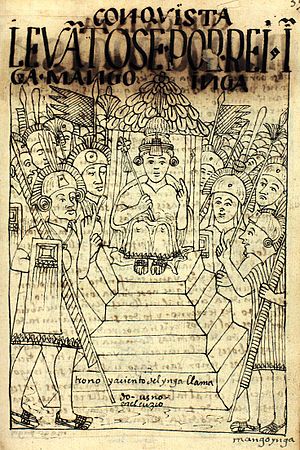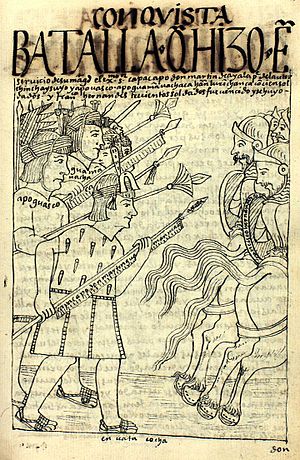Battle of Ollantaytambo facts for kids
Quick facts for kids Battle of Ollantaytambo |
|||||||
|---|---|---|---|---|---|---|---|
| Part of Spanish conquest of Peru | |||||||
|
|||||||
| Belligerents | |||||||
| Remnants of the Inca Empire | Spanish Empire Indian auxiliaries |
||||||
| Commanders and leaders | |||||||
| Manco Inca | Hernando Pizarro | ||||||
| Strength | |||||||
| 30,000+ | 100 Spaniards 30,000 native allies |
||||||
| Casualties and losses | |||||||
| Unknown | Unknown | ||||||
The Battle of Ollantaytambo happened in January 1537. It was a fight between the Inca army, led by Emperor Manco Inca, and a Spanish group led by Hernando Pizarro. This battle was part of the Spanish conquest of Peru.
Manco Inca was once a friend of the Spaniards. But he rebelled in May 1536. He then surrounded a Spanish army in the city of Cusco. To break this siege, the Spaniards decided to attack Manco Inca's main base. This base was in the town of Ollantaytambo.
Hernando Pizarro led the Spanish attack. His force included 100 Spaniards and about 30,000 native allies. They faced an Inca army of more than 30,000 soldiers. The Inca army successfully defended their position. They used high terraces and even flooded the ground to stop the Spanish cavalry. The Spaniards had to retreat to Cusco during the night.
Even though the Incas won this battle, Spanish reinforcements soon arrived in Cusco. This forced Manco Inca to leave Ollantaytambo. He moved to the thick forests of Vilcabamba. There, he set up a small, independent Inca state. This state lasted until 1572.
Contents
How the Battle Started
In 1531, a group of Spaniards arrived in the Inca Empire. They were led by Francisco Pizarro. This marked the start of the Spanish conquest of Peru. At that time, the Inca Empire had just finished a civil war. Atahualpa had defeated his brother Huascar to become the Sapa Inca, or emperor.
Atahualpa did not think the small Spanish force was a big threat. He was captured during a surprise attack in November 1532. This event is known as the Battle of Cajamarca. Pizarro ordered Atahualpa's execution in July 1533. Four months later, the Spaniards took over Cusco, the Inca capital.
Pizarro chose Atahualpa's brother, Túpac Huallpa, as a puppet ruler. A puppet ruler is someone who seems to be in charge but is controlled by others. Túpac Huallpa died soon after. So, another brother, Manco Inca, was crowned in his place. At first, many Incas who had fought against Atahualpa joined the Spaniards. They saw the Spaniards as allies against their old enemies.
For a while, Manco Inca and the conquistadors (Spanish conquerors) got along well. Together, they defeated Atahualpa's generals. They also brought back Inca rule to most of the empire. However, Manco soon realized that the Spaniards held the real power. In 1535, his home was robbed by Spaniards. They faced no punishment for it.
After this, the Spaniards often bothered the Inca emperor. They demanded gold, took his wives, and even put him in prison. Because of this, Manco Inca escaped his capital. He planned an uprising. In May 1536, an Inca army surrounded Cusco. A small group of Spaniards and their native allies defended the city.
The Spanish were in a tough spot. But they fought back and attacked the main Inca fort at Sacsayhuaman. Meanwhile, Manco's generals took control of the central highlands of Peru. They destroyed several Spanish groups sent to help Cusco. But they failed to capture Lima, the new Spanish capital.
Neither side could win the fight at Cusco for several months. So, the Spanish defenders decided to attack Manco's main base. This base was in the town of Ollantaytambo. It was about 70 kilometers (43 miles) northwest of Cusco.
Who Fought in the Battle
Manco Inca had gathered over 30,000 soldiers at Ollantaytambo. Many of these were new recruits from tribes in the Amazon Rainforest. Most of Manco Inca's army was made up of farmers. They were called a militia army. They had only basic training with weapons.
In the Inca Empire, military service was a duty for all married men. This included men between 25 and 50 years old. In battle, soldiers were grouped by their ethnic background. Their native leaders, called kurakas, led them.
Inca soldiers used weapons like maces, clubs, and spears. They also used ranged weapons like arrows, javelins, and slings. For protection, they wore helmets, carried shields, and wore padded cloth armor. Against the Spaniards, their wooden clubs and maces often could not break Spanish armor. Slings were a bit more useful because they were accurate and threw large stones.
Still, Inca soldiers were not as strong as Spanish cavalry on open ground. So, they chose to fight in rough areas. They also dug pits in open fields to slow down the Spanish horses.
The Spanish attack was led by Hernando Pizarro. He was the main Spanish commander in Cusco. His force had 100 Spaniards: 30 foot soldiers and 70 cavalry (soldiers on horseback). They also had about 30,000 native allies.
The Spanish cavalry was a big advantage against the Inca armies. Horses gave them more hitting power, better movement, speed, and endurance. All Spaniards wore some kind of armor. Most wore chain mail shirts or padded cloth armor. These were lighter and cheaper than full suits of armor. They also had steel helmets and small iron or wooden shields.
The main Spanish weapon was the steel sword. Horsemen also used lances. Both weapons could easily cut through the padded armor of Inca troops. Firearms like arquebuses (early rifles) were not used much. They were rare, hard to use, and horsemen thought they were not proper for gentlemen.
Spaniards relied heavily on their Indian auxiliaries (native allies). These allies provided thousands of warriors. They also helped with support and supplies. These native troops used the same types of weapons and armor as the Inca soldiers. In the Ollantaytambo campaign, Pizarro's group included many allies. These were mainly Cañaris, Chachapoyas, and Wankas. There were also some Inca nobles who were against Manco Inca.
The Battle of Ollantaytambo
The main way to get to Ollantaytambo is through a narrow valley. This valley is formed by the Urubamba River. It connects Ollantaytambo to Machu Picchu in the west and to Pisaq and Cusco in the east. After his uprising, Manco Inca made the eastern entrances strong. He wanted to stop attacks from Cusco, which the Spanish now held.
The first defense line was a steep bank of terraces at Pachar. This was near where the Anta and Urubamba rivers met. Behind this, the Incas changed the flow of the Urubamba River. They made it cross the valley back and forth. This created two more defense lines. These were supported by forts at Choqana and Inkapintay.
After these, on the plain of Mascabamba, eleven high terraces blocked the valley. These terraces were between the mountains and a deep canyon made by the Urubamba River. The only way through was a gate called T'iyupunku. This was a thick defensive wall with two narrow doors. If these defenses were broken, the Temple Hill offered a last line of defense. This was a religious center with high terraces overlooking Ollantaytambo.
The Spanish expedition had to cross the river many times. They fought hard at each river crossing. The main Inca army faced the Spaniards from terraces. These terraces overlooked a plain near the Urubamba River. Several Spanish attacks on the terraces failed. They were met with many arrows, slingshots, and large rocks thrown down from above. Attacks also came from both sides of the Spanish force.
To stop the Spanish cavalry, the Incas flooded the plain. They used channels they had prepared earlier. The water became so deep it reached the horses' bellies. Then, the Inca defenders attacked. Some of them even used Spanish weapons they had captured. These included swords, small shields, armor, and even a horse. Manco Inca himself rode this horse.
The Spanish were in a very bad situation. Hernando Pizarro ordered a retreat. Under the cover of darkness, the Spanish force fled through the Urubamba valley. The Incas chased them. The Spaniards reached Cusco the next day.
Where the Battle Happened
There is some debate about the exact place of the battle. Explorer John Hemming believes the Spanish were on a plain between Ollantaytambo and the Urubamba River. He thinks the main Inca army was on a citadel (the Temple Hill) above the town. This citadel was protected by seventeen terraces.
However, architect Jean-Pierre Protzen disagrees. He says the land around the town does not match old descriptions of the battle. An old account says the Inca army was on eleven terraces, not seventeen. Another old book by Pedro Pizarro describes a gate with walls as the only way through the terraces.
Protzen thinks these descriptions refer to eleven terraces that block the plain of Mascabamba. This plain is near Ollantaytambo. It includes the strong gate of T'iyupunku. At this spot, when the Spaniards faced the terraces, the Urubamba River would be on their left. The steep hill of Cerro Pinkuylluna would be on their right. This matches the three sides from which they were attacked. If Protzen is right, the river used to flood the battlefield was the Urubamba. It was not the smaller Patakancha river, which runs next to Ollantaytambo town.
What Happened After the Battle
The victory at Ollantaytambo made Manco Inca want to attack Cusco again. But the Spaniards found out the Inca army was gathering near the city. They launched a surprise night attack. This caused many casualties for the Incas.
On April 18, 1537, a Spanish army returned from a long trip to Chile. This army was led by Diego de Almagro. Almagro took over Cusco. He imprisoned Hernando Pizarro and his brother Gonzalo. Almagro wanted Cusco for himself. Most Spanish soldiers and their allies joined him.
Almagro had tried to make a deal with Manco Inca before. But his efforts failed when their armies fought near Cusco. With Almagro's forces making the Spanish position stronger, Manco Inca decided Ollantaytambo was too close to Cusco to be safe. So he moved further west to the town of Vitcos.
Almagro sent his officer, Rodrigo Orgóñez, to chase Manco. Orgóñez had 300 Spaniards and many native allies. In July 1537, Orgóñez captured and looted Vitcos. He took many prisoners, but Manco managed to escape. He found safety in Vilcabamba. This was a remote place where the Neo-Inca State was formed. This state lasted until 1572. That's when its last emperor, Túpac Amaru, was captured and executed.
See also
 In Spanish: Batalla de Ollantaytambo para niños
In Spanish: Batalla de Ollantaytambo para niños
- List of battles won by Indigenous peoples of the Americas
- Encomienda
- History of Peru
- Inter caetera
- Spanish colonization of the Americas




